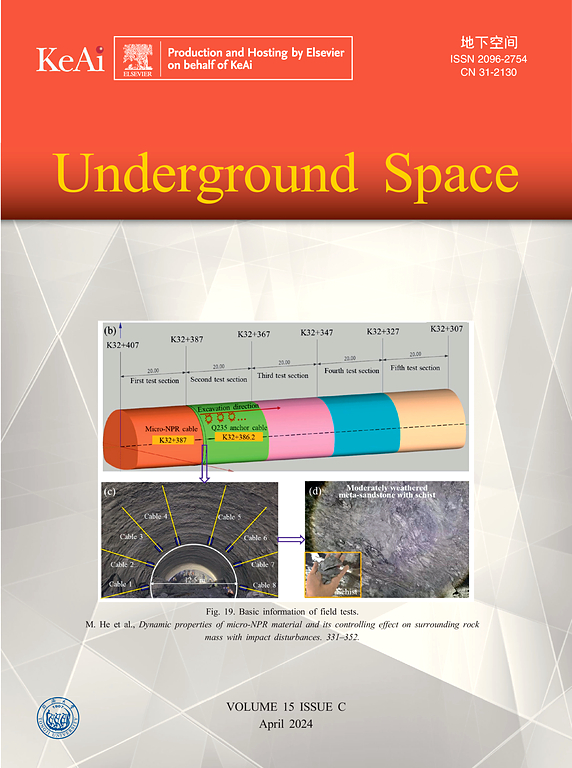面向未来弹性基础设施的无加固盾构隧道管片节理试验研究
IF 8.3
1区 工程技术
Q1 ENGINEERING, CIVIL
引用次数: 0
摘要
为了推进弹性基础设施,本研究探索了非加固盾构隧道管段技术,这是一个关键但研究不足的领域。对ecc基无筋段(ECCUS)进行了试验,将其与ecc基有筋段(ECCRS)和钢筋混凝土段(RCS)进行了比较,重点研究了其力学性能,包括材料特性、节段挠度、节点行为、螺栓应变、损伤扩展、破坏模式、节点韧性和延性。主要研究结果包括:(1)ECCUS节点承载力显著增强,其极限强度比RCS高34%,比ECCRS高29%;在初始开裂强度方面,ECCUS比RCS高200%,ECCRS高34%。(2) ECCUS中没有钢筋笼降低了刚度,但改善了整体节段协调和变形,导致挠度比RCS大100%,比ECCRS大85%。(3) ECCUS和ECCRS在200µm以下出现了大量细小的裂缝,而RCS在3 mm以上出现了较少、较宽的裂缝,导致明显的剥落。ECCUS的裂缝集中分布在剪切区和压缩区,而RCS和ECCRS的裂缝集中在压缩区。(4) ECCUS接头韧性显著,其弹性相韧性是RCS的13.47倍,ECCRS的1.91倍。在正常使用阶段,ECCUS的韧性是RCS的12.17倍,ECCRS的2.53倍。(5)考虑多尺度力学效应,ECCUS节点在弹性阶段将ECC的材料优势放大了11倍以上。这些发现为未来基于非加固建筑技术的弹性基础设施发展提供了有价值的见解。本文章由计算机程序翻译,如有差异,请以英文原文为准。
Experimental study on ECC-based unreinforced shield tunnel segmental joints for future resilient infrastructure
To advance resilient infrastructure, this study explores unreinforced shield tunnel segment technologies, a critical but under-researched area. It conducted experiments on ECC-based unreinforced segments (ECCUS), comparing them with ECC-based reinforced segments (ECCRS) and reinforced concrete segments (RCS), focusing on their mechanical properties, including material characteristics, segmental deflection, joint behavior, bolt strain, damage propagation, failure modes, joint toughness, and ductility. Key findings include: (1) ECCUS joints exhibited significantly enhanced bearing capacity, with ultimate strength 34% higher than RCS and 29% higher than ECCRS. In terms of initial cracking strength, ECCUS outperformed RCS by 200% and ECCRS by 34%. (2) The absence of reinforcement cages in ECCUS reduced stiffness but improved overall segment coordination and deformation, leading to deflections 100% greater than RCS and 85% than ECCRS. (3) ECCUS and ECCRS displayed numerous, fine cracks under 200 µm wide, while RCS showed fewer, wider cracks over 3 mm, leading to significant spalling. Cracks in ECCUS were densely distributed across shear and compression zones, in contrast to RCS and ECCRS where they concentrated on compression areas. (4) ECCUS joints exhibited remarkable toughness, with elastic phase toughness 13.47 times that of RCS and 1.91 times that of ECCRS. In the normal serviceability phase, the toughness of ECCUS was 12.17 times that of RCS and 2.53 times that of ECCRS. (5) Considering multi-scale mechanical effects, ECCUS joints amplified the material advantages of ECC over RC more than 11 times during the elastic stage. These findings offer valuable insights for future resilient infrastructure development based on unreinforced construction technologies.
求助全文
通过发布文献求助,成功后即可免费获取论文全文。
去求助
来源期刊

Underground Space
ENGINEERING, CIVIL-
CiteScore
10.20
自引率
14.10%
发文量
71
审稿时长
63 days
期刊介绍:
Underground Space is an open access international journal without article processing charges (APC) committed to serving as a scientific forum for researchers and practitioners in the field of underground engineering. The journal welcomes manuscripts that deal with original theories, methods, technologies, and important applications throughout the life-cycle of underground projects, including planning, design, operation and maintenance, disaster prevention, and demolition. The journal is particularly interested in manuscripts related to the latest development of smart underground engineering from the perspectives of resilience, resources saving, environmental friendliness, humanity, and artificial intelligence. The manuscripts are expected to have significant innovation and potential impact in the field of underground engineering, and should have clear association with or application in underground projects.
 求助内容:
求助内容: 应助结果提醒方式:
应助结果提醒方式:


